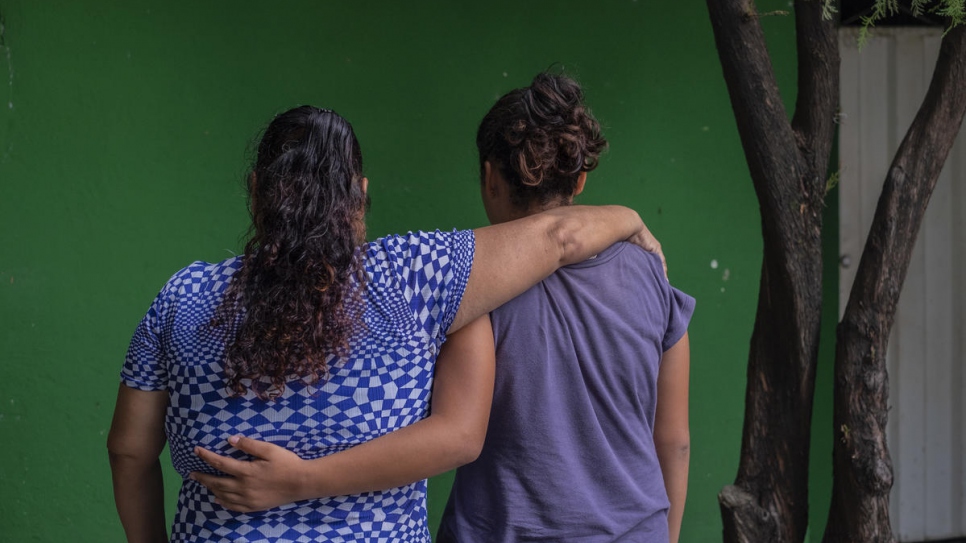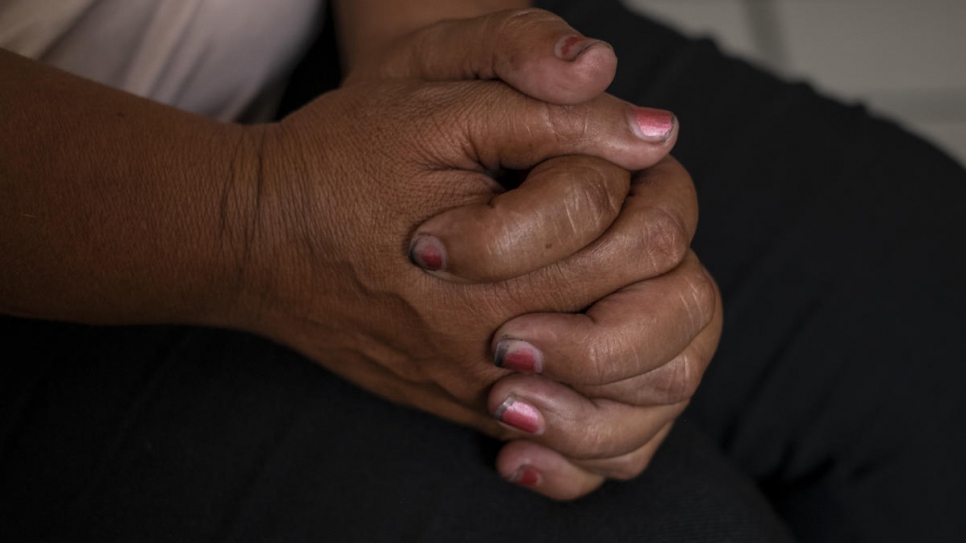Central American women find safety and strength in mural painting
An art project helps female asylum seekers from El Salvador and Honduras become more aware of their rights and discover a new family in Mexico.
Asylum seekers from north Central America in front of the mural they painted in Tapachula, Mexico.
© UNHCR/Marta Martinez
A new mural decorates the streets of Tapachula, the busiest town on the Mexican side of the border with Guatemala. In vivid earthy tones, it depicts a woman holding a baby in her arms, sprinkled with the names of the two dozen women from north Central America who painted it and profound words capturing their aspirations: love, trust, freedom, safety.
“This mural represents our daily fight to keep going, it tells our stories,” says Manuela*, a 48-year-old woman from El Salvador, pointing at the words she decided to paint on the mural: Let’s raise our voice.
Manuela has been escaping from the Salvadoran criminal gangs for five years. When she could not afford to meet the extortion fee they demanded – US $170 each week – she and her mother were harshly beaten. In one of those frightful visits, Manuela’s mother died of a heart attack.
Alone and desperate, Manuela moved to another town. The gangs found her six months later and threatened to kill her. She fell into a nightmarish never-ending exodus within El Salvador, spending no longer than one week in each location.
“There is no safe place in El Salvador,” Manuela says.
“I have found a family I did not know before.”
Despite feeling terrified, Manuela decided to join the “caravan” of over 7,000 people from Honduras, El Salvador and Guatemala heading north on foot looking for safety at the end of October 2018.
Another caravan departed from Honduras on January 14 and over 1,100 refugees and migrants crossed the Guatemala-Mexico border this week, including 145 children.
29,600 people have asked for asylum in Mexico in 2018 – more than a ten-fold increase over the last five years. They are mostly fleeing violence and persecution from Honduras (46 per cent), Venezuela (22 per cent) and El Salvador (21 per cent), some of the countries with the highest murder rate. Of all the asylum requests received by Mexican authorities, 56 per cent were processed in the southern state of Chiapas, where Tapachula is located.
The women who painted the 14-meter-long mural are mostly from Honduras and El Salvador. Some fled alone, others did it with their families or joined the “caravan,” like Manuela. They were threatened by gangs, raped, family members were killed in front of them – their life is at risk and they cannot go back to their country.
Over the course of two weeks, the women got together in early December to conceptualize, draw and paint the mural in a gender-based violence project supported by UNHCR, the UN Refugee Agency.
“UNHCR is working with different groups of asylum-seekers and refugees to allow them to have spaces where they can find safety, express their feelings and work through their trauma,” says Kristin Riis Halvorsen. “Many of these initiatives are focused towards women who are survivors of sexual and gender-based violence, which is widespread among the girls and women who come from Northern Central America.”
In the framework of the 16 Days of Activism against Gender-Based Violence, UNHCR organized a number of activities in Tapachula to raise awareness and improve networks for women to speak about their experiences. Because the issues the women have gone through are very complex and difficult to talk about, artistic projects were designed so that the women could have a different vehicle to express their feelings and, through a collective creation, reach a new level of confidence and finally start leaving their trauma behind.
“There is no safe place in El Salvador.”
As they learned how to use a brush and play with color, the women started trusting each other and realizing they were not alone in the abuses they had endured.
“We were able to relax, we laughed together, we forgot the problems in our countries,” says Janeth*, 45, from El Salvador.
Combined with art lessons were sharing exercises, where the women reflected on their traumatic experiences and became more aware of their rights. Most of them did not know they could ask for asylum until they reached the Mexican border.
“We thought that what our partners told us was because they loved us,” says Luisa*, a victim of sexual abuse from Honduras. “Now we know we have rights and we do not need to suffer.”
Janeth, 45, points at a hidden corner of the mural, near the floor. She painted a small tombstone with a big gray cross surrounded by flying birds. It has her 17-year-old son’s name on it.
“I wanted to capture my grief,” she says with reddened eyes.
Back in El Salvador, Janeth’s son could not escape the criminal gang who wanted to recruit him. His refusal to join cost him his life. When Janeth heard the gunshots from home one night in November 2017, shortly before going to bed, she knew.
El Salvador is one of the deadliest countries for young people in the world, especially young men. In 2015, 207.5 per 100,000 young people died, mainly due to homicides. This is significantly above the global average of 149, according to the World Health Organization (WHO). Secondary school enrollment is less than 38 per cent, well below the Latin American average of 74 per cent.
Janeth is still struggling with her son’s death, but she could not let depression overcome her – she needed to protect her daughter Alma*, who is 13 years old. The same gang who killed her son wanted to forcibly recruit Alma to become a gang member’s girlfriend, for what would have amounted to sex slavery.
“The mural makes us feel that we are human beings, that we are willing to survive regardless of what comes.”
The family fled to another town, where Alma had to switch schools every two months to remain in hiding. The gang found her six months later and she could not leave home.
They arrived in Tapachula less than a month ago. All the family wanted is to find a safe, stable place where Alma can continue her studies and become a nurse.
“I do not want to go to the United States, I want to study here,” Alma says.
- See also: Helping refugees to thrive in Costa Rica
When reflecting on the art project, the women stress how helpful it has been for all of them.
“The mural makes us feel that we are human beings, that we are willing to survive regardless of what comes,” Luisa says. “But we wouldn’t be able to do it without the support of the institutions.”
When Luisa sees tattooed men on the streets, her body still shakes reliving the trauma she went through back in Honduras, when she was raped by two hooded men. But in Tapachula she feels safe.
“I have found a family I did not know before,” she adds.
Excited and proud about the results of the art project, the women look forward to continue learning skills that can help them find jobs in Tapachula, like performing beauty treatments, tailoring or baking.
Smiling, Luisa adds: “After this, we might become artists.”
*Names changed for protection reasons.





